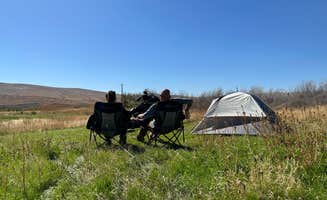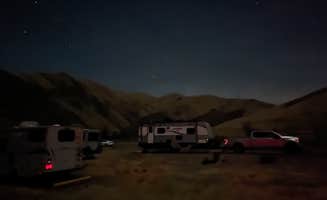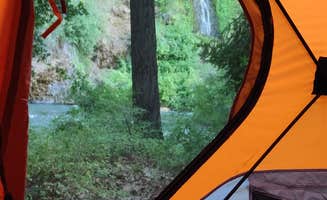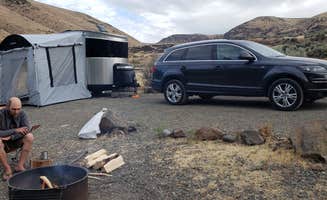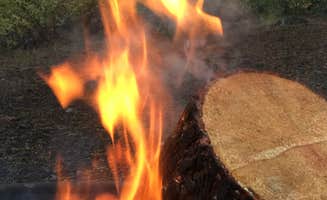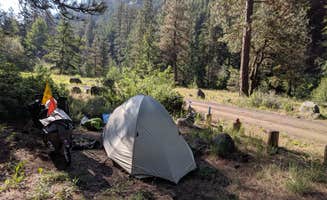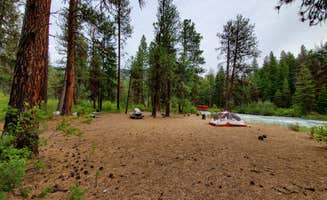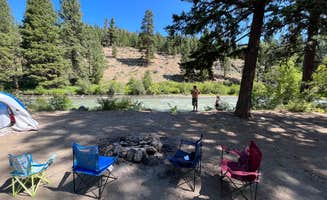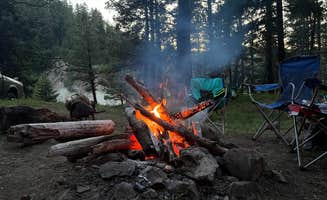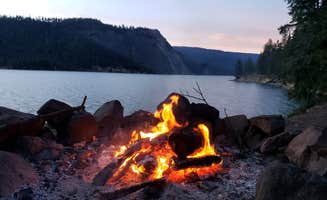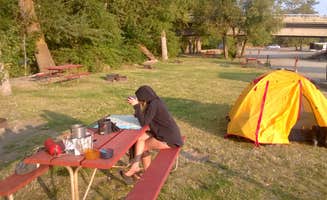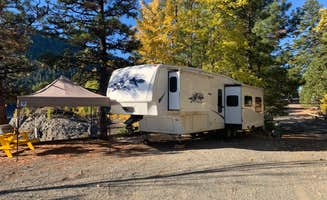Camping in Yakima WA offers opportunities at elevations ranging from 1,066 feet in the valley to 5,600 feet in nearby mountain areas. The region's semi-arid climate creates distinct camping zones, with Yakima averaging less than 8 inches of rainfall annually. Daytime temperatures in summer frequently reach triple digits at lower elevations, while overnight temperatures can drop dramatically due to the desert climate pattern.
What to do
Hiking trails and petroglyphs: The region offers numerous hiking opportunities with varying difficulty levels. Umtanum Creek Trail crosses a suspension bridge and follows a desert canyon. "The path was really good, clear, and easy to find. There were a few waterfalls, and creeks to cross to just know that your shoes/feet might get a little wet," notes one Umtanum Campground visitor.
Water activities: The Yakima River provides multiple recreation opportunities. "One of our favorites. Right on the Yakima river, fishing. Boating, floating the river. Watching Elk, Bighorn Sheep, Eagles and Pelicans," writes a camper at Big Pines Campground. Several sites offer direct river access for fishing, floating, or simply cooling off during hot summer days.
Wildlife viewing: The transition zone between desert and riparian environments creates diverse wildlife habitat. One camper at Umtanum noted, "Many deer in the area, even walking through the campsite at times. The hiking is a pleasure in the area, with lots of wildlife." Morning and evening hours provide best viewing opportunities for various bird species and mammals native to the region.
What campers like
River access: Sites situated along the Yakima River remain among the most popular. A visitor to Roza Campground described it as a "Great spot on a calm bend in the river. Great location and 20 min to Yakima or 15 to reds fly shop." Many river sites offer direct water access without steep embankments.
Desert landscape views: The stark beauty of the shrub-steppe environment provides a different camping experience than western Washington forests. "The landscape is really gorgeous and colorful," notes a camper at Ginkgo Petrified Forest State Park. Sites offer views of basalt cliffs, sagebrush plateaus, and river corridors with minimal light pollution for stargazing.
Proximity to town amenities: Many camping locations provide a balance of outdoor experience while remaining accessible to services. A camper at Yakima Sportsman State Park noted it's "Close to town, nice, quiet clean park. Rangers are very helpful." This accessibility allows campers to resupply or access restaurants without long drives.
What you should know
Limited shade: Most Yakima area campgrounds feature minimal natural shade. One camper at Big Pines noted, "Large Campground right on the river. very little shade. Vault toilets. Great place to stay for floating the river or fishing." Bringing canopies or other portable shade structures is advisable during summer months.
Wildlife awareness: The region hosts rattlesnakes during warmer months, particularly in rocky areas. "This area is known for rattlesnakes, though so definitely be alert," cautions a camper. Most encounters occur on trails rather than in developed camping areas, but awareness is important throughout the region.
Water availability: Many BLM sites along the Yakima River Canyon do not provide potable water. A camper at Yakima River Canyon Campgrounds noted, "Dry camping only but close to Yakima." Bringing adequate water supplies is essential, especially during hot summer months.
Tips for camping with families
Swimming options: Look for river sites with calm water sections for safer water play. One camper at Windy Point Campground shared, "The river is so beautiful with the waterfall cascading down into the river directly across from the campsite. There is a shallow part near the shoreline where the kids had a great time playing in the river."
Kid-friendly activities: Several campgrounds offer open spaces and facilities designed for children. At Yakima Sportsman State Park, a camper noted, "There is plenty of space for kids to play and visibility is high for bike riding. There is a huge group campsite that has bathrooms near it. The surrounding grounds is a park with playground equipment and a huge field."
Educational opportunities: The region offers numerous opportunities to learn about geology, wildlife, and cultural history. "The Ginko Petrified forest has amazing views alongside an interpretive center with cool rock formations and ancient petroglyphs," notes a visitor, providing educational experiences for children during camping trips.
Tips from RVers
Hookup considerations: Electric and water availability varies significantly between campgrounds. An RVer at Ellensburg KOA advised, "This is right off I90 very convenient but close to freeway so some road noise. I90 is the main east west freeway in Washington. It is right on the river and there's a pool."
Site selection: Premium riverside sites often fill quickly but offer the best experience. One RVer recommended, "If you get one of the sites in the back and on the river it's actually really nice and spacious! A bit older without the typical amenities, but all I wanted were hookup, big site, and waterfront."
Weather preparedness: The region experiences significant temperature fluctuations and wind. A camper noted, "It got really windy at night," while another mentioned temperature extremes requiring preparation for both hot days and cool nights, particularly during spring and fall camping trips.


